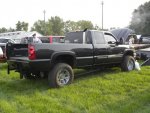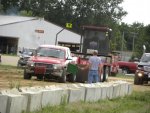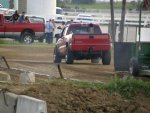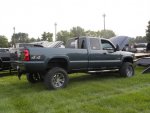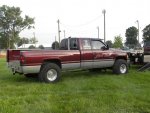We had a set of 4 scales that did up to 8K.
We did not test any diesels (too heavy), but we did several gassers in several different styles/years to discuss the advantages of wheelbase. One of the many things we tried that day was take a 6 liter gas 2500HD and see what happened with torsion bars up and down (trying to settle a similar debate). Obviously it weighed within 2 lbs each time, but when the bars were down (no weight on the back), there was slightly more weight on the front axle than with the bars cranked (weight transferred to the back as the bars cranked). I don't remember exactly how much but it was less than 100 lbs.
The thing I found interesting is we put three small guys in the back sitting off the tailgate (combined weight of ~530) to simulate hitch downforce. We found more weight (compared with just bar cranking) transferred to the rear axle with the bars cranked than with them dropped (I assume it would only be worse with a sled pulling down).
We also found that more weight percentage wise lifted off the front and transferred to the rear on short wheelbase trucks (which most people thought would happen).
Another interesting thing we found is we took my 1980 reg cab longbed and a 4 door shortbed ~98 V10. My truck weighed 6070 and the other weighed 6720 in daily trim. My truck had a 58.8/41.2 front to rear weight split and the other was 58.6/41.4 front to rear weight split (pretty dang close). We weighted mine at the front of the bed to equal 6720 and found it changed my weight ratio to 56.9/43.1

There has been talk of upping the weight class to allow newer vehicles to pull as many weigh more than 6200 from the factory, but also coming up with a way to keep it fair (other than hanging weight) for the Old Skoolers......
As for the torsion bars pushing down on the front.....Nope. If you took the torsion bars out and the weight of the truck was supported by the front axle there would be more weight on the front end (overall truck weight would be the same........minus the missing torsion bars). As the torsion bars suspend the front of the chassis/body above the axle, weight is transferred to the back, the higher the front the more weight transfer to the rear and the less pressure on the front tires. You might say there is more push downward as the springs are loaded/tensioned but for every action there is an equal and opposite reaction (lifting of the chassis and weight transfer).
I could see cranking tbars if CV shaft angles are negative while pulling (i.e. hanging insane amounts of weight off the front) to help keep them level, or if your suspension is wacky and the rear ends up hooking better than your front (such as 2WD pullers or those without a front locker).



